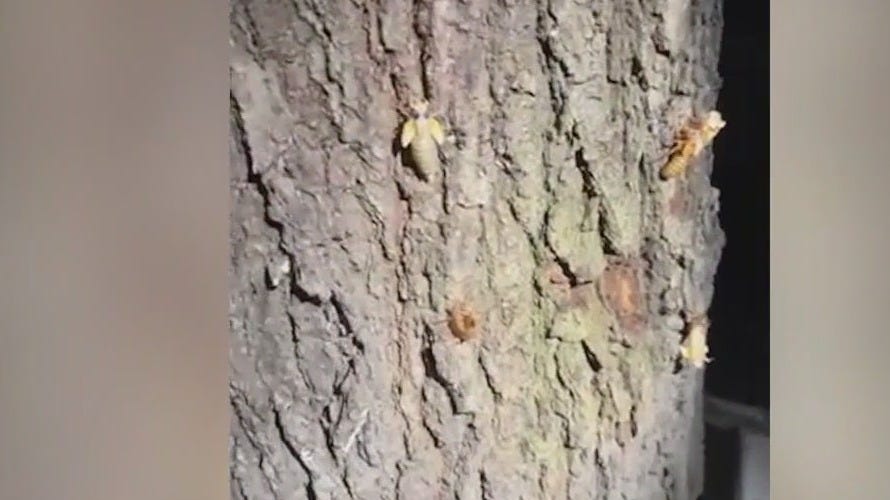Cicada Brood XIV, first recorded by the Pilgrims, is emerging once again
These cicadas, first identified in 1634, have lived underground for 17 years and are expected to spread from Georgia to Indiana.

The first insects in what will become a massive, 13-state swarm of cicadas has begun emerging in the South, a biological marvel that will begin slowly making its way north as temperatures rise, bringing with it millions upon millions of the loud and annoying – but harmless – insects.
The first reports of periodical cicadas emerging from their long wait underground came over the weekend from Fayette County, Tennessee and Buncombe County, North Carolina, according to the citizen science site Cicada Safari, which allows Americans to track the insect's path across the nation.
Known as Brood XIV, it's the nation's second largest periodical cicada brood and its emergence will be witnessed by a good portion of the eastern United States.
"Everything looks on target for them this week in northern Georgia, then probably central Tennessee next week and then the following week in northern Tennessee and southern Kentucky," said Gene Kritsky, a cicada expert at Ohio's Mount St. Joseph University.
"Then by the middle of May they'll be in Cincinnati and the rest of Kentucky and in another week in Maryland and DC and then Philadelphia the following week."
All told, this group of 17-year cicadas will emerge in various parts of Georgia, Kentucky, Indiana, Maryland, Massachusetts, North Carolina, New Jersey, New York, Ohio, Pennsylvania, Tennessee, Virginia and West Virginia.
Brood XIV (that's 14 if you've forgotten your Roman numerals) last appeared in 2008.
Last year was an especially big year for cicadas, with the rare, overlapping emergence of two different broods, Brood XIII and Brood XIX. The two broods last emerged in 1803, and the next double-emergence is predicted in 2245.
When Brood XIV begins to emerge, it will be the last periodical cicada brood to emerge from the ground for a while, Kritsky said. The next major brood, XXIII, won't reappear until 2028 throughout the Mississippi River valley.
Periodical cicadas – an amazing natural event
Periodical cicadas are a fascinating insect with a remarkable life cycle. They spend the bulk of their lives living underground as nymphs, where they feed off the sap of tree roots.
There are two types, one that lives as a nymph for 13-years and one 17-years. After spending those years slowly growing underground, they emerge when the soil surface temperatures reach 64 degrees, which is just beginning to happen now.
Once above ground, they spend several hours drying their wings, then go in search of food and mates.
Cicadas do not eat plant leaves, flowers or fruit but instead suck fluid from the stems of woody shrubs and trees with a long, straw-like tube called a rostrum.
Once the females mate, they settle on tree branches where they make a slit in the bark to deposit their eggs. Six to eight weeks later the eggs hatch and the tiny nymphs fall to the ground and burrow into the soil where they latch on to tree roots and begin the cycle again.
All told they spend only three to five weeks above ground before dying
Periodical cicadas hatch in groups that are called broods and which are designated by Roman numerals, a practice that was began in 1907 by Charles Lester Marlatt, a Kansas-born entomologist at the U.S. Bureau of Entomology.
There are also cicada species that emerge every year, called annual cicadas.
The Pilgrim's Brood
This group of cicadas, Brood XIV, is sometime's known as the Pilgrim's Brood because the emergence of the flying insects was first recorded in 1634 by William Bradford, the second governor of Plymouth Colony.
"The pilgrims didn't know about periodical cicadas," said Kritsky. "They're unique to the eastern part of the United State. The pilgrims didn't realize they would return in 17 years."
In his journal, Bradford wrote “… such a quantity of a great sort of flies … which came out of holes in the ground … and ate the green things, and made such a constant yelling noise, as made all the woods ring of them, and ready to deaf the hearers,” according to Kritsky, whose book, "Pilgrims' Promise: The 2025 Emergence of Periodical Cicada Brood XIV" came out earlier this year.
There's nothing to fear from cicadas
Cicadas offer a wonderful example of a beneficial ecological system.
The cicadas “prune” mature trees but don’t harm them. They don’t eat flowers or vegetables. Pretty much the only part of the yard that could possibly hurt would be young, new trees, said Kritsky.
For those with newly planted trees, garden stores sell mesh that can go over them to protect them.
Once the cicadas die, around five weeks after emerging, they decompose quickly, a natural process that's good for vegetation.
Most importantly, don’t buy pesticides and spray your backyard to get rid of them, said Kritsky. There are too many of them to be affected by poisons but animals – including pets – that eat dead cicadas could be harmed.
Help create a better map of Brood XIV
Citizen scientists can help create a fuller widespread map of Brood XIV this year.
Americans can download the app Cicada Safari and then report periodical cicada emergences by taking photographs and submitting them. Once they've been verified, they will be posted to a live map. As of Monday the Cicada leaderboard listed five emergences.
Cicada Safari was created by Kritsky working with the Center for IT Engagement at Mount St. Joseph.
"We've never had a good, thorough and widespread map of Brood XIV," he said. "We got a good map of Brood X in 2021 from citizen scientists and now we can create one for Brood XIV."